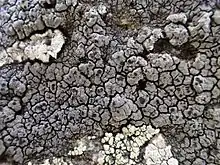Schaereria fuscocinerea
Schaereria fuscocinerea is a species of saxicolous (rock-dwelling), crustose lichen in the family Schaereriaceae.[2] It was first formally described in 1852 by Finnish lichenologist William Nylander, as Lecidea fusco-cinerea.[3] Georges Clauzade and Claude Roux transferred it to the genus Schaereria in 1985.[4] The species has a cosmopolitan distribution and is found in both northern and southern hemispheres, where it grows on hard siliceous rocks, often in arctic and mountainous areas. Similar species include Lambiella gyrizans and L. mullensis, which can be distinguished from Schaereria fuscocinerea by microscopic and chemical characteristics.[5]
| Schaereria fuscocinerea | |
|---|---|
 | |
| in France | |
| Scientific classification | |
| Domain: | Eukaryota |
| Kingdom: | Fungi |
| Division: | Ascomycota |
| Class: | Lecanoromycetes |
| Order: | Schaereriales |
| Family: | Schaereriaceae |
| Genus: | Schaereria |
| Species: | S. fuscocinerea |
| Binomial name | |
| Schaereria fuscocinerea | |
| Synonyms[1] | |
|
List
| |
References
- "Synonymy: ". Species Fungorum. Retrieved 9 September 2023.
- "Schaereria fuscocinerea (Nyl.) Clauzade & Cl. Roux". Catalogue of Life. Species 2000: Leiden, the Netherlands. Retrieved 9 September 2023.
- Nylander, W. (1852). "Observationes aliquot ad synopsin lichenum Holmiensium". Botaniska Notiser (in Latin). 1852: 175–180.
- Clauzade, G.; Roux, C. (1985). Likenoj de Okcidenta Europa. Ilustrita determinlibro. Bulletin de la Société Botanique du Centre-Ouest (in Esperanto). Vol. 7. p. 829.
- Gilbert, O.L.; Hawksworth, D.L. (2009). "Schaereria Körb (1855)". In Smith, C.W.; Aptroot, A.; Coppins, B.J.; Fletcher, F.; Gilbert, O.L.; James, P.W.; Wolselely, P.A. (eds.). The Lichens of Great Britain and Ireland (2nd ed.). London: The Natural History Museum. p. 834. ISBN 978-0-9540418-8-5.
This article is issued from Wikipedia. The text is licensed under Creative Commons - Attribution - Sharealike. Additional terms may apply for the media files.